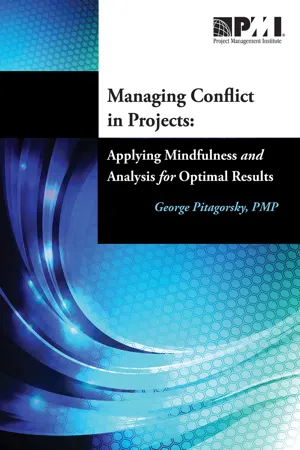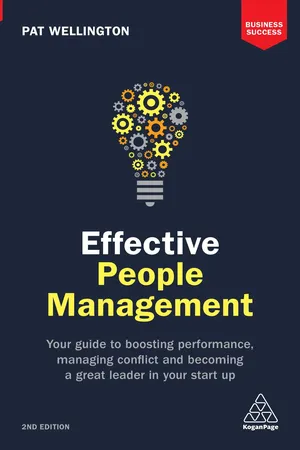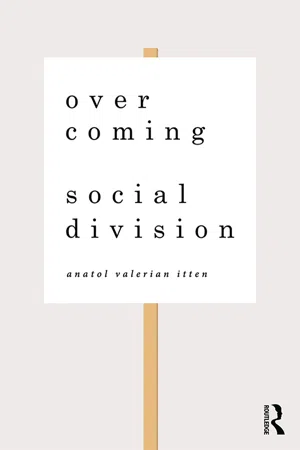Conflict Process
The conflict process refers to the series of stages that occur when disagreements or disputes arise within an organization. It typically involves five stages: potential opposition or incompatibility, cognition and personalization, intentions, behavior, and outcomes. Understanding and managing the conflict process is crucial for maintaining a healthy and productive work environment.
7 Key excerpts on "Conflict Process"
- eBook - ePub
Managing Conflict in Projects
Applying Mindfulness and Analysis for Optimal Results
- George Pitagorsky(Author)
- 2012(Publication Date)
- Project Management Institute(Publisher)
...Consider how a formal procurement process at least attempts to minimize emotion-based conflict and promote an even playing field with rules that set a structure that benefits the buyer and sellers. Consider the metaphor of tuning an instrument. Make the strings too tight, and they will break as you are playing; if they are not tight enough, you won't get the sound you want. In managing conflict, make the process resilient and leave it open for interpretation and moment to moment decision making by the players while at the same time including sufficient rigor and discipline to avoid unnecessary problems and promote a desired end result. Process Definition Unifies the Conflicting Parties The definition of the conflict management process can occur at the beginning of a project as part of kicking off the project, as part of organizational planning and behavioral skills training or it can occur at the onset, or at any time, during a conflict. Ideally, the parties dynamically work together to define or tailor their process, assess its practicality, agree upon, sustain and continuously refine their approach. It is an opportunity to create a subtle shift from antagonistic disputants to members of a team who join forces to confront the conflict as opposed to one another. Of course, there may be conflicts about the way to address the conflict, and these can take a good deal of effort to resolve. In the negotiations to end the Vietnam War, there was a lengthy dispute over the shape of the negotiators’ table. However, these process disputes are easier to address than the core conflict itself. If they are not addressed and reconciled, they will come up and influence the core conflict. The focus on process increases the probability that the right techniques will be used, making an optimal outcome more likely...
- eBook - ePub
- Paul Smith, Marilyn Farmer, Wendy Yellowley(Authors)
- 2013(Publication Date)
- Routledge(Publisher)
...This could be conflict between management and workers as a result of differences of interest (see Chapter 1 on the employment relationship), or between different managers or departments, or between different employees. One of the key roles of management will be to manage that conflict, via techniques such as communication, consultation, discussion and compromise, negotiation and bargaining. Such efforts may not always be totally successful, and conflict may manifest itself in various ways: on a collective basis in the form of strikes, for example, and on an individual relationship basis in the form of arguments, grievances and so on. In the latter case, viewing organizations as rational and adopting a unitary perspective, if conflict is manifested it will be seen as indicating a failure, of management or of systems. If everyone in the organization shares the same goals – that is, the success of that organization – and if management authority and prerogative are accepted, then conflict should not occur. Luckily, we do not have to adopt one view or the other; organizations can be viewed as being a mix of the rational and the political. KEY TERM Conflict: a process that begins when one party perceives that another party has negatively affected, or is about to negatively affect, something that the first party cares about (Thomas 1992, in Robbins, Judge and Campbell 2010: 400). It can be argued that conflict is not necessarily a bad thing; rather, it can have both positive and negative outcomes. Positive outcomes may include new ideas and people having to search for new ways of doing things, creativity, clarification of views and standpoints, as well as ‘clearing the air’. Less positive outcomes may include individuals feeling unhappy and mistrustful, individuals and groups concentrating on their own narrow self-interests, and resistance, plus manifestations such as employee turnover and industrial action...
- eBook - ePub
Effective People Management
Your Guide to Boosting Performance, Managing Conflict and Becoming a Great Leader in Your Start Up
- Pat Wellington(Author)
- 2017(Publication Date)
- Kogan Page(Publisher)
...10 Proactive conflict management Introduction Conflict means disagreement, to battle, to be at odds. It seems to be an inevitable part of human interaction and occurs (at home or at work) when an individual’s needs, desires, values or intentions are in opposition with those of another person (or group). This definition suggests that those involved see their goals as incompatible and the achievement of these goals as being interfered with. Sometimes these differences are real, at other times they are imagined. Either way, the persons involved must see differences and believe they are important for conflict to emerge. If there are no differences there is no motivating force for conflict. The potential for conflict exists everywhere. At some time or other, we all find ourselves in situations where discussions spin out of control, and, instead of cooperating, we become emotional and angry, which if not managed and resolved effectively (and quickly) imposes significant personal (and organizational) cost on those involved. When the energies involved are under control they have potential for good. Out of control they can be forces for ill. A manager’s first priority is to view conflict as not always inherently bad. If handled correctly, the dynamics surrounding conflict can change radically. Some conflicts are relatively minor, easy to handle, or may be simply ignored. Others of greater magnitude require a strategy for successful resolution if they are not to create constant tension or lasting enmity at home or at work. If we recognize the causes that lead to conflict, we can usually steer ourselves and others away from the damage it can cause. I’m always surprised by the small things that can unleash a full-scale row, aggressive language (verbal or non-verbal) or taking actions calculated to annoy. The stages of a team’s development As a manager, your aim is to help your team reach and sustain high performance as quickly as possible...
- eBook - ePub
Project Management Leadership
Building Creative Teams
- Rory Burke, Steve Barron(Authors)
- 2014(Publication Date)
- Wiley(Publisher)
...An alternative for business is to create a partnership of two or more companies, effectively combining together to address a task. However, conflict can still occur in partnership situations when one party tries to achieve the common goal in a manner undesirable to the other. A conflict situation involves emotions that work to drive and reinforce the conflict. Issues must be dealt with at an emotional level in order to escape the conflict. The leader should review issues about emotional intelligence (see Chapter 9 on Emotional Intelligence) for ways of identifying personal strengths in this area. The conflict situation can manifest through emotions that affect people in one or more of the following ways: Behavioral – the way the conflict is expressed through verbal/non-verbal and intentional/unintentional behaviors. Physiological – the way people feel inside about the conflict situation; for example, how does it affect their self-image? Cognitive – the way people think about the conflict; how do they assess or appraise the situation to determine relevance to their point of view? Though there is this emotional component, the root of the conflict can lie in a challenge to people’s personal or cultural values, their achievement of goals and the way they want to achieve their goals or in their understanding of the facts. The sources of the conflict need to be identified in one or more of these categories if the situation is to be resolved. For example, if the conflict relates to a difference in factual understanding, we might investigate whether one of the parties in the dispute is working with some assumptions that they are treating as facts. If it was possible to test what people are taking to be truth, then we might be able to identify misconceptions that could break the deadlock. Conflicts over facts, goals and methods are more likely to be resolved in a straightforward manner than issues involving values...
- eBook - ePub
Making Collaboratives Work
How Complex Organizational Partnerships Succeed
- Susan Meyers Chandler(Author)
- 2018(Publication Date)
- Routledge(Publisher)
...If these goals reflect the basic core values of the group, accomplishing this outcome will be easier. Conflicts often emerge when some of the group members feel that others in the group do not share, understand, or appreciate their values, perspectives, ideas, or concerns. A well-designed conflict-resolution system is a process that avoids, or at least manages, disputes that may evolve. Such a system may include group-process activities such as teaching active-listening skills to the members, group agenda-setting exercises, working in small task groups, bringing in substantive experts, conducting joint fact-finding experiences, and/or having the leader or facilitator demonstrate and practice interpersonal sensitivity and skill in managing conflict within the group’s dynamics. Campbell and O’Leary (2015) suggest that the earlier a conflict is managed (any type of conflict), the better. They support Carpenter and Kennedy’s (1988) conceptualization that there is an upward spiral to unmanaged conflict if not attended to. An initial problem can fester, resulting in a hardening of positions; communication may totally stop; conflict can spread outside of the organization; and perceptions can become distorted. If these things occur, then a much larger crisis is likely to emerge, and be hard to resolve. Positions and Interests Fisher and Ury (1991) identify two common approaches when parties attempt to negotiate in order to solve a problem or disagreement. One is the positional approach to negotiation (sometimes called distributive) and the other is interest-based (also called integrative) negotiation. In positional negotiation, a person has a single, particular solution in mind (a position) and the negotiation will move only when this side concedes to a new position. This is usually problematic, since the final result may not be reflective of the interests of either party...
- eBook - ePub
Overcoming Social Division
Conflict Resolution in Times of Polarization and Democratic Disconnection
- Anatol Valerian Itten(Author)
- 2018(Publication Date)
- Routledge(Publisher)
...These constitute the principle areas within which research has been conducted. Conflict resolution dynamics is therefore not a term frequently used in the literature. However, as Emerson et al. (2009, 39) remark, some researchers have identified the importance of process dynamics such as opening lines of communication, developing mutual understanding, active engagement and learning together, as well as collective recognition of mutual interdependence. We can assume that the mediator’s behaviour affects and influences the behaviour of the disputants, whereas equally, the disputants’ behaviour affects and influences the mediator’s behaviour (Wall and Dunne 2012, 229), but there is no clarity about specific mediation situations that occur regularly and the effect they have on the proceedings and the outcome of a conflict resolution process. Understanding these process dynamics has implications for the further development of conflict resolution (Holaday 2002). In their public mediation framework, Orr et al. (2008, 295) include a term which they denote as ‘participants are effectively engaged’. Within this term, they define four elements as major contributors to all sorts of mediation agreements: (1) participants communicate and collaborate; (2) participants understand each other’s views and perspectives; (3) participants’ understanding of issues improves; and (4) participants narrow and clarify the issues in dispute. These forms of collaborative engagement can be understood as the groundwork for the other dynamics to develop. Hence, the authors assume that a high level of collaborative engagement is reached when all participants continue to work together cooperatively and are committed until the end of the process. Furthermore, a cooperative work atmosphere should facilitate the balanced inclusion of all affected interests...
- eBook - ePub
Say What!? Communicate with Tact and Impact
What to say to get results at any point in an audit
- Ann M. Butera(Author)
- 2021(Publication Date)
- CRC Press(Publisher)
...10 Managing and Resolving Conflicts DOI: 10.1201/9781003093978-10 Conflict cannot survive without your participation. Wayne Dyer Self-development author and speaker At some point during your career, you will have to deliver bad news. When you do, you might expect the other person to question (read: challenge) your ideas, what you did and how you did it. Why? Because skepticism and pushback are a natural human reaction to bad news. And, if you read Chapter 9 you are now prepared to respond and deal with the other party’s objections and pushback. In fact, if you have taken my advice to heart, you will not only expect the pushback – you will almost look forward to it because you recognize objections for what they truly are: the areas or topics that need to be addressed before the other person agrees with the information you are providing. If you aren’t getting pushback after you have described a high-risk situation, a control gap, a control design flaw, or a control execution error, you are either talking to (1) someone who is not responsible for the area, (2) someone who already knows about the problem (which may be due to scarce or insufficient resources) and wants you to report the condition so that senior leadership will take action to correct it, or (3) someone who is not listening to you. While having the ability to deal with objections is important, it doesn’t mean that you will be able to avoid conflict entirely. 10.1 Sources and Symptoms of Organizational Conflict The potential for organizational conflict is inescapable. Recall typical team formation according to Bruce Tuckman’s Stages of Group Development. Initially a group forms, then storms and norms before it performs as a team. Forming and storming are basic, unavoidable steps in this process. The storming stage occurs before norming (rule-setting) can occur. However, when the group can’t progress into the norming step (i.e., cannot come up with ways to fix or avoid problems), conflict can sprout...






